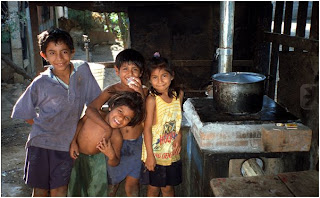As per a report in National Geographic, in two small villages on Nicaragua’s Mosquito Coast, a project to improve electricity service had a remarkable side benefit—household energy use actually dropped nearly 30 per cent. When efficient compact-fluorescent (CFL) lightbulbs were added to the mix, energy savings surpassed 40 percent.
“It shows that you can meet development objectives for the poor and climate objectives for all of us at the same time,” said Daniel Kammen, chief technical specialist for renewable energy and energy efficiency at the World Bank, and co-author of an analysis published in the weekly journal Science,The Energy-Poverty-Climate Nexus.
As per National Geographic.com, the study set out to demonstrate a method for measuring both the climate and financial benefits of making investments that improve delivery of reliable, affordable energy for poor communities. Mobilizing such investment is crucial, with 1.5 billion people around the world living without electricity. Another 1 billion people have unreliable electricity, and nearly half the global population relies on unhealthy and polluting wood, charcoal, and dung stoves for cooking.
The United Nations said in a report co-written with the International Energy Agency that its goals for fighting extreme poverty will fall short unless nations also work to bring electricity and modern, safe cooking technology to the “energy-poor” people around the world.
The analytical method outlined in the paper is “very helpful for certain contexts, particularly for looking at how increasing energy efficiency can help support energy access," says Richenda Van Leeuwen, senior director on energy and climate for the the United Nations Foundation, a non-profit that supports the work of the UN. She said she especially sees potential for the approach to be adapted for addressing the global problem of primitive cookstoves. Inefficient wood and waste stoves, used by 3 billion people around the world, create black carbon particulate emissions, a large contributor to climate change, and have a devastating impact on health—especially for women and children.
“There is really room for more research in this area for both traditional cooking and kerosene-based lighting, which both emit smoke,” Van Leeuwen said. “You could begin to monetize the savings of fewer trips to clinics, and fewer treatments for acute pneumonia and other respiratory illnesses that are common among people breathing in cookstove smoke day in and day out.”
Van Leeuwen said the approach is among those being weighed by the new public-private partnership, the Global Alliance for Clean Cookstoves, the United Nations; global energy company Shell and its Shell Foundation; investment bank Morgan Stanley; and the nonprofit SNV-Netherlands Development Organization.
Kammen’s new study underscores the importance of doing a similar analysis for the world’s poor, who can spend more than 30 percent of their income on energy services. In wealthy countries, only 2 to 3 percent of Gross Domestic Product is spent on energy. “Because energy services are often expensive,” said Kammen, “finding ways to provide them more efficiently benefits the poor more than the rich.”
Representative photograph: 2009 UNEP Sasakawa Prize Co-Laureates
Read the full story on: Fighting Poverty Can Save Energy, Nicaragua Project Shows
skip to main |
skip to sidebar
THE READING LIST
- World Lung Foundation: Acute Respiratory Infections Atlas
- Searching for Fundi and studying the three-stone stove in Kalinzi
- Karibu Tena: Rocket Stoves in Mwamgongo
- Black Carbon Emissions in Asia
- Capacity Development for Scaling Up Decentralized Energy Access Programmes: Lessons from Nepal on its role, costs, and financing
- The Indian National Initiative for Advanced Biomass Cookstoves: The benefits of clean combustion
- The Hartwell Paper: A new direction for climate policy after the crash of 2009
- PERU HEALTHY KITCHEN/HEALTHY STOVE PILOT PROJECT
- US Climate Bill: Kerry Lieberman' American Power Act
Followers
Blog Archive
-
▼
2010
(93)
-
▼
December
(13)
- Flying To Support Clean Cookstoves
- The Role Of Micro-Entrepreneurs In Promoting Stove...
- The Priority Is Building Better Stoves And Creatin...
- Clean Cookstoves: Inexpensive Solution to Maternal...
- Cancun Talks Pave Way for Environmental Benefits
- EPA and Peace Corps to Assist Clean Cookstove Dist...
- The Making Of Estufa Finca
- Malta Joins Global Alliance For Clean Cookstoves
- Halima's Prize Winning Stove In Dafur
- The Jompy Stove: World Challenge Finalist
- Global Alliance For Clean Cookstoves Engages Cancu...
- Better Energy Makes For Lesser Energy Use
- Re-emerging TB in Africa Linked To Poverty
-
▼
December
(13)
IMPROVED COOK STOVES
VIDEO RECORD
Enterprise Based Solutions for Improved Cook Stoves
Routes to Market for Improved Cook Stoves
Shell Foundation Press Conference on Indoor Air Pollution
Interview Jeroen Blum, Deputy Director, Shell Foundation
Clearing the Air on Indoor Air in Koppal
Khidki Amma Noses Around
Envirofit Cookstove Ambassador Minniamma
South India Pilot Campaign
Shell Foundation Campaign in Shimoga
Secretary Clinton Announces the Global Alliance for Clean Cookstoves
The Burden of Firewood
The Silent Killer In The Kitchen
The Stove Solution
The Stove Solution
The Aprovecho Institutional Rocket Stove
Step by step guide to build a RIPPLE Rocket fuel efficient cookstove
Malawi – The RIPPLE Rocket fuel efficient cookstove


